Ancient Religions, Modern Politics: The Islamic Case in Comparative Perspective by Michael Cook

Author:Michael Cook
Language: eng
Format: mobi, epub, pdf
Publisher: Princeton University Press
Published: 2014-03-23T00:00:00+00:00
3. HINDUISM
In turning to the Hindu case let us begin where we just ended, with law. As a phenomenon, Hindu law resembles Islamic law in some basic ways, and yet for reasons that we will come to, the idea of restoring its hegemony has played virtually no part in the politics of modern India, even among the Hindu nationalists. Once we have considered the question of law, it will not take long to generalize our findings to the Hindu religious tradition at large.
Hindu law, like the Sharīʿa, is a religious law. It grounds its claim to authority in revelation—not ongoing revelation, but again a process that was accomplished long ago.185 In the meantime the law has come to be embodied in a dense scholastic tradition; here the counterparts of the Muslim jurists (faqīhs) are the śāstrīs. Again, like the Sharīʿa Hindu law covers both worldly matters and many aspects of specifically religious life.186 Thus, one modern scholar describes it as “a system of thought containing a body of detailed rules, tackling every facet of life,”187 while another remarks of Manu that only a small part of the text deals with “what we would call law”;188 this is just the kind of thing that is said about the Sharīʿa. Moreover Hindu law is arguably central to Hinduism in something of the way the Sharīʿa is to Islam. It is known as dharma, which is also the word for religion in general; thus law is religion par excellence. These points have a couple of closely related implications that feel familiar to any student of Islamic law. One is that whatever the superficial diversity of opinions among the jurists, it is axiomatic that the law is so far as possible to be construed as one: “all authoritative texts spoke with one voice” and “all contradictions were only apparent.”189 The other implication is that in some sense the law is immutable; it is the “eternal law” (sanātana dharma).190 In the light of our discussion of this point in the Islamic context, this latter implication is worth taking a little further.
Just as in the Islamic case, the idea of an unchanging law has as much to do with rhetoric as reality. There are in fact significant mechanisms of adjustment at the interface between the prescriptions of eternity and the instability of human affairs. For example, Manu confronts the question what is to be done where no law is laid down; the answer is that a committee (pariṣad) of ten or more qualified persons, or three, or even a single Brahmin, can decide the law (whereas thousands of unlearned people cannot constitute such a committee);191 this is a more institutional approach than we would find in Islamic law. At the same time an old doctrine says that the substance of the law may vary from one age (yuga) to another. In particular, practices that were lawful in earlier ages may be prohibited in the present degenerate Kali age (kaliyuga); juristic sources provide lists of such now forbidden practices (kalivarjyas).
Download
Ancient Religions, Modern Politics: The Islamic Case in Comparative Perspective by Michael Cook.epub
Ancient Religions, Modern Politics: The Islamic Case in Comparative Perspective by Michael Cook.pdf
This site does not store any files on its server. We only index and link to content provided by other sites. Please contact the content providers to delete copyright contents if any and email us, we'll remove relevant links or contents immediately.
| Buddhism | Christianity |
| Ethnic & Tribal | General |
| Hinduism | Islam |
| Judaism | New Age, Mythology & Occult |
| Religion, Politics & State |
Cecilia; Or, Memoirs of an Heiress — Volume 1 by Fanny Burney(31341)
Cecilia; Or, Memoirs of an Heiress — Volume 3 by Fanny Burney(30938)
Cecilia; Or, Memoirs of an Heiress — Volume 2 by Fanny Burney(30894)
The Secret History by Donna Tartt(16643)
Sapiens: A Brief History of Humankind by Yuval Noah Harari(13067)
Leonardo da Vinci by Walter Isaacson(11912)
The Radium Girls by Kate Moore(10914)
Sapiens by Yuval Noah Harari(4546)
The Wind in My Hair by Masih Alinejad(4427)
How Democracies Die by Steven Levitsky & Daniel Ziblatt(4407)
Homo Deus: A Brief History of Tomorrow by Yuval Noah Harari(4287)
Endurance: Shackleton's Incredible Voyage by Alfred Lansing(3852)
The Silk Roads by Peter Frankopan(3769)
Man's Search for Meaning by Viktor Frankl(3644)
Millionaire: The Philanderer, Gambler, and Duelist Who Invented Modern Finance by Janet Gleeson(3574)
The Rape of Nanking by Iris Chang(3522)
Hitler in Los Angeles by Steven J. Ross(3443)
The Motorcycle Diaries by Ernesto Che Guevara(3340)
Joan of Arc by Mary Gordon(3262)
